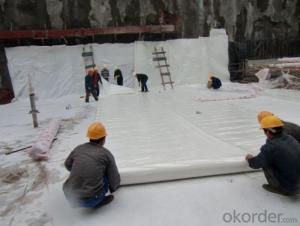HDPE Self-adhesive Waterproof Membrane 1.5mm
- Loading Port:
- Tianjin
- Payment Terms:
- TT or LC
- Min Order Qty:
- 5000 m²
- Supply Capability:
- 100000 m²/month
OKorder Service Pledge
OKorder Financial Service
You Might Also Like
HDPE Waterproof Membrane
High-density Polyethylene (HDPE) Self-adhesive Waterproof Membrane is specially used in underground project, it can bond with concrete layer tightly. After Membrane bonding with concrete, water can be blocked between membrane and concrete, which can improve the reliability.
Product Applications:
Basement,Subway,Tunnel Cave, Other underground public constructions.
Product Advantages:
1. Good bonding with concrete applied on membrane, to block water between membrane and concrete further to protect concrete effectively.
2. Low flatness requirement to substrate, reliable overlapping; mechanical fixing, easy application.
3. Sound anti-puncture performance.
4. Adaptable to settlement and distortion.
5. Weather-resisting and anti-UV.
6. Resist to acid, alkali, mold.
7. Eco-friendly material
Product Specifications:
Width(m) | Length(m) | Thickness(m) |
1.2 or 2.4 | 20 or more | 1.2 or 1.5 |
Test item | Test Method | Unit | Requirement | ||
Water tightness to liquid water | EN 1928 | — | 60KPa,24h,Pass | ||
Resistance to static loading | EN 12730 | Kg | 20 | ||
Tensile force | Longitudinal | EN 12311-2 | N/50mm | ≥800 | |
Transversal | EN 12311-2 | N/50mm | ≥800 | ||
Elongation/ | Longitudinal | EN 12311-2 | % | ≥500 | |
Transversal | EN 12311-2 | % | ≥500 | ||
Durability of water tightness against chemicals | EN 1847 Test afterwards to EN1928 | - | 60KPa,24h,Pass | ||
Durability of water tightness against ageing | EN 1296 Test afterwards to EN1928 | - | 60KPa,24h,Pass | ||
Resistance to impact | EN 12691-B | mm | 600mm | ||
Resistance to tear(Nail Shank)-unreinforced sheets | Longitudinal | EN 12310-1 | N | ≥500 | |
Transversal | EN 12310-1 | N | ≥500 | ||
Peel resistance of joint | EN 12317-2 | N/50mm | ≥400 | ||
Resistance to alkali | EN 1847 Test afterwards to EN1928 | - | 60KPa,24h,Pass | ||
Length | EN 1848 | m | ≥20 | ||
Width | EN 1848 | m | 2.4±0.024/1.2±0.012 | ||
Mass per unit area | EN 1849 | Kg/m2 | ≥1.45(1.5mm); ≥1.15(1.2mm) | ||
Straightness | EN 1848 | mm/10m | ≤20 | ||
Visible defects | EN 1850 | - | No visible defects | ||
Bitumen compatibility | EN 1548 | - | 60KPa,24h,Pass | ||
FAQ:
Q: Can I visit your company?
A: Yes, welcome to visit our enterprise.
Q: Can I do the third party testing before loading?
A: Yes, we could accept the third party testing.
Q: Which kind of payment in your company?
A: We could accept TT, LC at sight, etc.
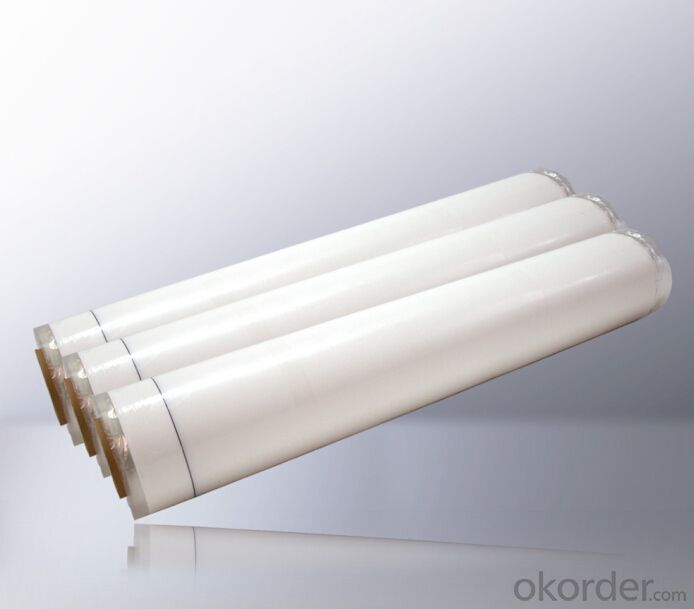
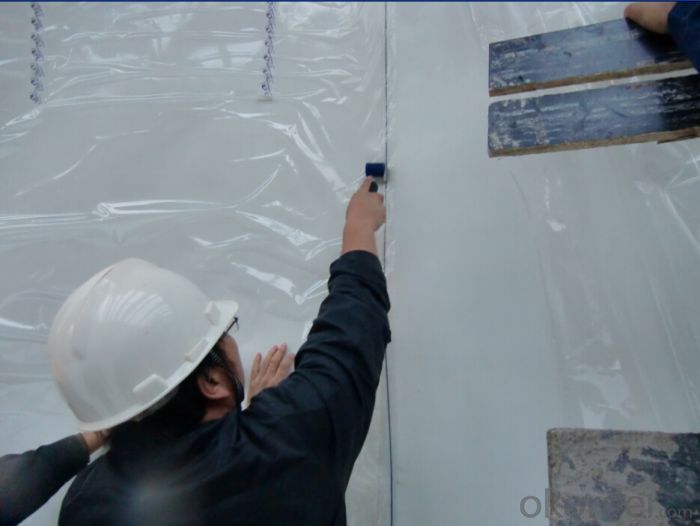
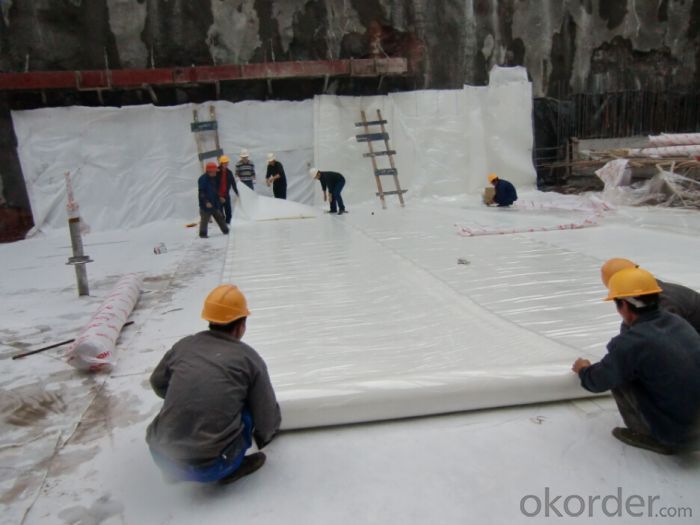
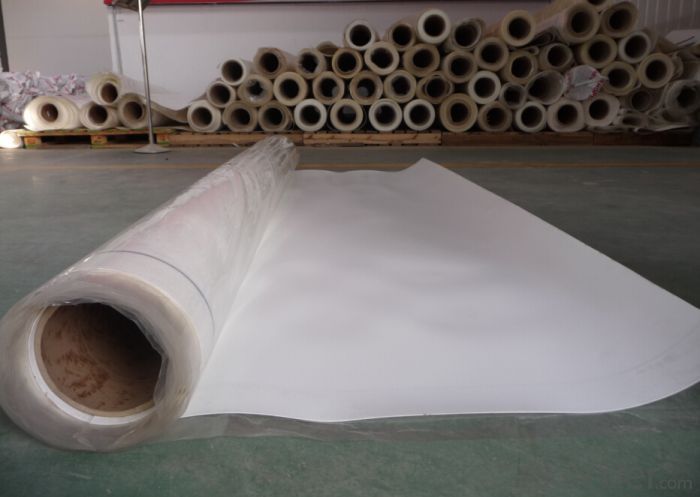

- Q:How does a waterproofing membrane adhere to the substrate?
- The substrate is adhered to by a waterproofing membrane through a combination of diverse mechanisms. The primary approach involves the utilization of adhesives that are specifically engineered to bond the membrane to the surface. Depending on the type of membrane and substrate, these adhesives can be either solvent-based or water-based. Additionally, certain waterproofing membranes possess a self-adhesive backing that obviates the necessity for a separate adhesive application. These membranes commonly feature a peel-off backing that reveals a sticky surface, facilitating effortless installation onto the substrate. Another approach to achieving adhesion involves employing mechanical fasteners. In this scenario, the membrane is firmly affixed to the substrate via screws, nails, or comparable fasteners. This method is frequently employed when the membrane needs to be attached to a rigid surface, such as concrete or metal. The selection of adhesive or fastening method relies on various factors, including the type of waterproofing membrane, the substrate material, and the specific requirements of the application. It is crucial to adhere to the instructions and guidelines provided by the manufacturer to ensure proper adhesion and a durable waterproofing solution.
- Q:Are there any specific considerations for installing a waterproofing membrane on wood surfaces?
- Yes, there are several specific considerations for installing a waterproofing membrane on wood surfaces. Firstly, it is important to ensure that the wood surface is clean, dry, and free from any debris or loose material. This will help in achieving a proper adhesion of the waterproofing membrane. Additionally, it is crucial to choose a membrane specifically designed for wood surfaces, as they may require additional flexibility and resistance to expansion and contraction. It is also recommended to apply a primer or sealer to the wood surface before installing the membrane to improve its adhesion and longevity. Lastly, regular inspection and maintenance of the waterproofing membrane is essential to identify any potential issues and ensure its effectiveness over time.
- Q:Can a waterproofing membrane be used on precast nickel surfaces?
- Yes, a waterproofing membrane can be used on precast nickel surfaces. Waterproofing membranes are designed to create a barrier against moisture and prevent water penetration. They can be applied to various surfaces, including concrete, metal, and even nickel. However, it is important to ensure that the waterproofing membrane is suitable for use on nickel surfaces and is compatible with the specific type of precast nickel being used. It is recommended to consult with a professional waterproofing contractor or the manufacturer of the membrane for guidance on the specific application and to ensure proper adhesion and effectiveness of the membrane on precast nickel surfaces.
- Q:Sbs waterproofing membrane can make bathroom waterproof?
- And can be used in the basement, bridges, parking lots, swimming pools, tunnels and other buildings waterproof, moisture, steam, impermeable and various types of roof maintenance works, and the service life is very long, basically not bad,
- Q:Can a waterproofing membrane be used in cold climates?
- Yes, a waterproofing membrane can be used in cold climates. In fact, many waterproofing membranes are specifically designed to withstand extreme temperatures, including freezing conditions. These membranes are engineered to remain flexible and durable even in cold environments, ensuring effective protection against water infiltration and damage.
- Q:Does a waterproofing membrane have any impact on the appearance of a surface?
- The appearance of a surface can be affected by a waterproofing membrane. When it is applied to a wall or floor, the membrane acts as a barrier to prevent water or moisture from entering. This process typically involves adding a coating or layer that can change the texture or shine of the surface. Occasionally, the membrane might result in a slight color variation or darken the surface. Nevertheless, there are transparent or colorless waterproofing membranes accessible that have minimal impact on the appearance of the surface. Ultimately, the extent to which the appearance is influenced depends on the specific type of waterproofing membrane utilized and the desired aesthetic result.
- Q:Are there any specific installation requirements for waterproofing membranes?
- Yes, there are specific installation requirements for waterproofing membranes. These requirements may vary depending on the type of membrane being used, but there are some general guidelines that apply to most installations. Firstly, it is important to properly prepare the surface that the membrane will be applied to. This may involve cleaning the surface, removing any loose debris or previous coatings, and ensuring the surface is smooth and free from any irregularities. This step is crucial as it allows for better adhesion between the membrane and the surface. Next, the membrane should be applied according to the manufacturer's instructions. This typically involves using a suitable adhesive or bonding agent to adhere the membrane to the surface. It is important to follow the recommended application rate and ensure that the membrane is applied evenly and without any air bubbles or wrinkles. In addition to proper application, it is also important to pay attention to the seams and joints of the membrane. These areas are particularly vulnerable to water penetration, so they should be carefully sealed using an appropriate sealant or tape. This ensures a watertight seal and prevents any water from seeping through the seams. Lastly, it is important to protect the installed membrane from any damage during and after installation. This may involve covering the membrane with a protective layer, such as a geotextile fabric or a layer of soil, to prevent punctures or tears. Additionally, any construction or landscaping work that may occur after the installation should be done with caution to avoid damaging the membrane. Overall, the specific installation requirements for waterproofing membranes will depend on the type of membrane being used and the specific conditions of the project. It is always recommended to consult the manufacturer's instructions and guidelines to ensure proper installation and long-lasting waterproofing performance.
- Q:Can a waterproofing membrane be used for swimming pools?
- Yes, a waterproofing membrane can be used for swimming pools. Waterproofing membranes are designed to prevent water penetration and can be installed on various surfaces, including concrete, to create a watertight seal. This is particularly important for swimming pools as they are constantly exposed to water and require a reliable waterproofing system to prevent leaks and water damage. The waterproofing membrane acts as a protective barrier, ensuring that the pool remains water-tight and preventing any water from seeping into the surrounding structures. Additionally, waterproofing membranes can also provide resistance against chemicals, UV rays, and other environmental factors, further enhancing the durability and longevity of the swimming pool.
- Q:Can a waterproofing membrane be used in conjunction with insulation materials?
- Yes, a waterproofing membrane can be used in conjunction with insulation materials. In fact, it is often recommended to use both together in order to provide a comprehensive solution for protecting buildings from moisture and enhancing energy efficiency. The waterproofing membrane acts as a barrier to prevent water infiltration, while insulation materials help to regulate temperature and reduce heat loss or gain. By combining these two components, the building envelope can be effectively protected from water damage and insulated to maintain a comfortable indoor environment. It is important to ensure that the waterproofing membrane is properly installed and compatible with the insulation materials to achieve optimal performance and longevity.
- Q:Can a waterproofing membrane be used for plant rooms and mechanical equipment areas?
- Plant rooms and mechanical equipment areas can benefit from the use of a waterproofing membrane. It is necessary to waterproof these areas in order to safeguard the equipment and surrounding structures against water damage. A waterproofing membrane serves as a commonly implemented solution for this purpose. By forming a barrier, it effectively prevents water infiltration into the plant rooms and mechanical equipment areas, thereby ensuring the equipment remains dry and protected. Moreover, this membrane aids in averting moisture-related problems like the growth of mold and mildew, which can be detrimental to both the equipment's functionality and the overall operation of the plant room. Ultimately, incorporating a waterproofing membrane in plant rooms and mechanical equipment areas proves to be a dependable and efficacious approach for maintaining the longevity and performance of the equipment and structures.
1. Manufacturer Overview |
|
|---|---|
| Location | |
| Year Established | |
| Annual Output Value | |
| Main Markets | |
| Company Certifications | |
2. Manufacturer Certificates |
|
|---|---|
| a) Certification Name | |
| Range | |
| Reference | |
| Validity Period | |
3. Manufacturer Capability |
|
|---|---|
| a)Trade Capacity | |
| Nearest Port | |
| Export Percentage | |
| No.of Employees in Trade Department | |
| Language Spoken: | |
| b)Factory Information | |
| Factory Size: | |
| No. of Production Lines | |
| Contract Manufacturing | |
| Product Price Range | |
Send your message to us
HDPE Self-adhesive Waterproof Membrane 1.5mm
- Loading Port:
- Tianjin
- Payment Terms:
- TT or LC
- Min Order Qty:
- 5000 m²
- Supply Capability:
- 100000 m²/month
OKorder Service Pledge
OKorder Financial Service
Similar products
New products
Hot products
Related keywords
